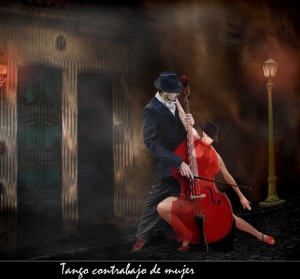Here is a brief, very basic primer for beginners in tango, which I wrote for Inspira Travel, an agency here in Buenos Aires for whom I’ll lead some tango-themed tours in November. You can check out their site, too, for great trips all around Argentina.
Tango music is something the most unschooled among us recognize when we hear it. Even if we don’t know what a bandoneon is, we know that concertina-like sound, blending with violins and perhaps some piano music. We recognize the beat, technically called “two-by-four,” even if we know nothing about music. And above all, we know the emotions of the tango sound, the varying mix of lament, woe, romance, passion, and every nuance in-between.
Once you start going to milongas, where tango music is played for dancers, you quickly learn that tango can be broadly divided into three categories—pure tango (the dos por quarto or two by four), tango vals or waltz (similar to American waltz), and tango milonga, a word also used to describe the rhythmic music whose roots go back to the African slaves. Tango milonga invites lots of syncopation, called traspies, in the dance steps.
And then, within these three categories, there are numerous interpretations depending on the composer. Too, too numerous to describe here – but here’s a good book to pick up and learn more: Tango, Let’s dance to the music! By Joaquin Amenabar.
So, the more I dance tango and learn about the music through the way it affects my dance, the more difficult it is for me to answer that FAQ: Who are your favorite composers?
Yet, I will try here: Carlos di Sarli (The RCA years) is a favorite – he is my tops for romantic tango music. Di Sarli has songs in all three types of tango music, too. You can’t go wrong with anything by him.
Ah, Pugliese – Osvaldo Pugliese. He is probably considered the most romantic for many tangueros. And I do love to listen to his wildly creative interpretations. Who could not love La Yumba, Mala Junta, and Mariposa?-to name just a few of his eternal themes. Here’s a little secret about Pugliese I just learned from Joaquin Amenabar: The milonga DJs play his 1950s radically passionate stuff – but it’s not danceable. Well, that explains why unlike most milonga attendees I always want to sit out that tanda and just watch the dancers wrap themselves as one to his music. BUT, get hold of Pugliese’s 1940s music – and you’ll hear it’s much more tempo-friendly for dancing. You can find a CD of his 1940s music anywhere here in Buenos Aires – just ask the clerk. Also, look for a composer, lesser known, but equally passionate to Pugliese, Alfredo Gobbi. You’ll be amazed how similar they sound. Gobbi died too young to achieve the fame of Pugliese, who made it to his nineties.
Let me drop a few more names that you might want in your collection: Francisco Canaro-make sure you get La Poema (romantic tango); Juan D’Arienzo, the King of Rhythm; Rodolfo Biaggi (very rhythmic -too much so for some dancers); Anibal Troilo (rhythmic is a softer way) – anything by these Golden Era composers is great.
Start with the above Composers. When you’re ready to add more styles to your collection, look for any tangos by De Angelis, Tanturi, Laurens, DeCaro, Calo . . . and I’ll stop there for now. Not all tangos have lyrics but when they do, here are the great voices to look for: Francisco Fiorentino, Alberto Castillo, Julio Sosa, Raul Beron, Angel Vargas, and of course, the immortal Carlos Gardel.
That’s enough name-dropping for now to keep you busy.

Hi! Thanks for your great article! I found it as I was looking for tango pictures on the net. I really love the picture you attached to your article (contrabajo de la mujer) and was wondering where you found it: is it yours? I would love to use it for a tango night we have for our small group here in GValway (Ireland) but wanted to ask first of cours!
Thanks for your time
How about female singers and musicians? Could you recommend some?